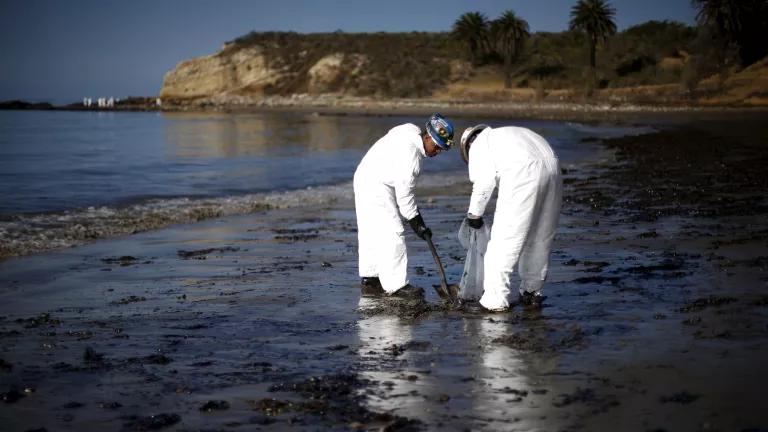
Workers clean up an oil slick along the coast of Refugio State Beach in Goleta
On a typical day, Refugio State Beach, in California's Santa Barbara County, is an idyllic palm-treelined cove—a refuge, if you will. But thanks to an oil pipeline rupture yesterday, its now-blackened sands are the site of a massive cleanup effort. A citizen first reported the leak around noon, and the Coast Guard had stopped it by 3 P.M.—but an estimated 21,000 gallons of crude oil still spilled onto the shore and into the Pacific Ocean, creating a four-mile-long sheen. There are no reports yet of oil-stricken wildlife, but the area is home to an array of species, such as sea lions and seabirds, as well as migrating whales.
The pipeline, owned by Plains All American, is capable of transporting 150,000 barrels of crude every day, from a facility owned by Exxon Mobil.
If reading this story is giving you déjà vu, there’s good reason. First, Santa Barbara's beaches were fouled with crude oil in 1969 during what was the third-largest oil spill in United States waters. Second, the company owns another pipeline that spilled 10,000 gallons of oil in L.A.'s Atwater Village a year ago. And third, the accident is just the latest addition to the long list of pipeline ruptures and oil train derailments that have taken place in 2015. And since 1995, more than 5,600 major pipeline accidents have killed an average of 18 people annually and cost nearly $7 billion total in damages. This, by the way, is the record for the safest method of energy transportation.
This article was originally published on onEarth, which is no longer in publication. onEarth was founded in 1979 as the Amicus Journal, an independent magazine of thought and opinion on the environment. All opinions expressed are those of the authors and do not necessarily reflect the policies or positions of NRDC. This article is available for online republication by news media outlets or nonprofits under these conditions: The writer(s) must be credited with a byline; you must note prominently that the article was originally published by NRDC.org and link to the original; the article cannot be edited (beyond simple things such grammar); you can’t resell the article in any form or grant republishing rights to other outlets; you can’t republish our material wholesale or automatically—you need to select articles individually; you can’t republish the photos or graphics on our site without specific permission; you should drop us a note to let us know when you’ve used one of our articles.

This Is How We Stand Up to Trump
I Hate Reruns
Why Florida Needs an Offshore Drilling Ban—One That’s Permanent